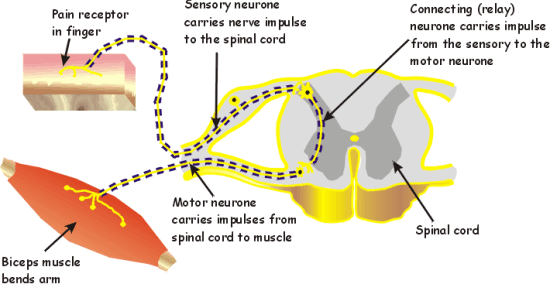Reflex Arc
Reflex actions are automatic involuntary actions. They are often there to keep us from harming ourselves. For example if we were to touch something very hot with our hand, a reflex action would swiftly move it away from the source of danger. The diagram below is a representation of what is known as a reflex arc.

The pain receptors in the finger sense the pain and stimulate the sensory neurone. Sometimes the pain receptors are separate cells but can also be a part of the sensory neurone itself. Once the sensory neurone has been stimulated an electrical impulse travels along its length to the spinal cord. The cell bodies of the sensory neurones can all be found in the same region of the nerve fibre and a swelling called a ganglion is formed because of them. The sensory neurone is connected to a relay neurone via a synapse. If the impulse from the sensory neurone is big enough then the relay neurone is triggered which in turn triggers the motor neurone. This stimulates the effector organ, in this case the biceps muscle which contracts moving the hand away from danger. The relay neurone also sends a message to the brain so it knows what is going on. Often the reflex action has occurred before the brain knows that the hand was in danger. Reflex actions are quick because they only have a few nerves (as few as three in some cases) and needs no conscious control. Reflex actions are hardwired into the body. The same stimulus always gives the same response. Memory has no effect on the response to the stimulus.
Voluntary actions are more complex as they require many neurones and are always under conscious control. Things like memory can play a part and so these actions tend to be much slower. The same stimulus can lead to different responses depending on the situation.
